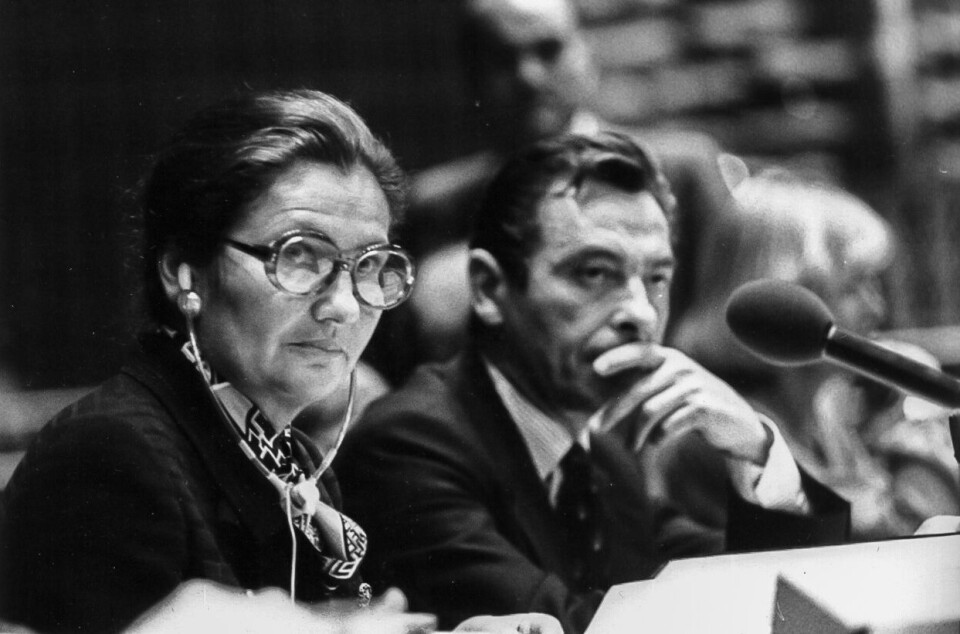-
Trump tariff rises: which American items will be worst hit and when?
Three rounds of escalating tariffs will impact €22 billion worth of US goods
-
Ballet lessons bring health benefits to over-55s in France
Online classes with the Silver Swans are transforming lives of older adults
-
Trump calls for Marine Le Pen to be freed (but she is not in prison)
US president said her embezzlement court case was a ‘witch hunt’
Simone Veil: a force for good, for women, for France, for all
We reveal how this formidable woman used her political career to fight for the underdog

The life story of Simone Veil, née Jacob (1927-2017), could have been tragic, but her strength and determination turned it into a triumph.
Born in Nice, when France was occupied during WW2, Simone’s family was not initially at risk. They lived in the non-occupied zone, and were non-practicing Jews.
Simone was a very good pupil and despite having to study at home to avoid attention from the authorities, in 1944 she passed her baccalauréat at the age of 16.
Arrested by the Gestapo
On her way back from the exam, planning to celebrate her success, she was arrested by the Gestapo.
Her whole family had been living separately, staying on friends’ sofas under assumed names to avoid notice, but now they were all rounded up and deported.
Her father and brother were sent to Lithuania but died on the journey, and their bodies were never recovered.
Auschwitz
Simone, her mother, and her sister Madeleine were sent to Auschwitz.
Simone’s forearm was tattooed with the number 78651.
Her other sister, Denise, was arrested in Lyon later that year and sent to Ravensbrück, from where she was liberated.
In January 1945, Simone, Madeleine and their mother were part of the forced ‘death march’ from Auschwitz to Bergen-Bergen concentration camp, where her mother died of typhus.
Simone, Madeleine and Denise were all liberated in April 1945. This horrifying experience marked Simone Veil forever.
Determined to improve life for everyone
She was determined to improve life for everyone, but for women in particular.
She was also determined to transmit her experiences so that nothing would be forgotten; she wanted to ensure nothing remotely similar could happen again.
Back in France, however, she found that very few people wanted to hear about her time in Nazi concentration camps.
In 1946, at university studying law and political science in Paris, she met and married Antoine Veil. Together they had three sons, Jean (b. 1947), Claude-Nicolas (1949-2002), and Pierre-François (1954-2002).
When Antoine’s job took him to Germany, she moved there with him.
Differentiate between Nazis and Germans
It was important, she declared, to differentiate between Nazis and Germans.
Between 1945 and 1949, Germany was divided into four zones which were occupied and administered by the British, Americans, French, and Russians respectively.
Despite her personal experiences, or perhaps because of them, Simone Veil was amongst the first to lobby for Franco-German reconciliation after the war.
She said the rise of the Nazi party leading to the Holocaust could have happened anywhere.
Tragically, in 1952, her sister Madeleine died in a car accident travelling back from Germany. The loss was all the worse because it left Simone with no-one to talk to about their mutual traumatic WW2 experiences.
Career beginnings
Back in France again, she began her career as a lawyer, and then in 1954, became a French magistrate.
At the Ministry of Justice, she worked to improve treatment and conditions for women in prison.
During the Algerian War she arranged for female Algerian prisoners threatened with rape and other abuses to be transferred to France.
She was extraordinary.
Fewer than 40% of French woman had jobs
At that time in France, fewer than 40% of French women had jobs. The percentage was even lower amongst the upper and middle classes.
So her career raised eyebrows, and questions were asked by traditionalists about her ‘duties’ as a wife and a mother.
In 1964, Simone became the Director of Civil Affairs, where she worked for women’s rights.
She established dual legal responsibility in matters concerning the family, and also established women’s right to adopt.
She regarded the events of May 1968 with equanimity, saying that the younger generation were not wrong. (For seven weeks in 1968, students went on strike against capitalism, consumerism and traditional values. The protests and strikes heralded a cultural and social revolution which still resonates today.)
Becomes secretary general of the Supreme Court
In 1970, Simone became secretary general of the Supreme Court, and from 1974 to 1979 she was Minister for Health.
She was only the second woman to become a French minister, after Germaine Poinso-Chapuis in 1947.
As Health Minister, Simone Veil pushed through two vital laws about reproductive rights.
The first was access to contraception, in particular the contraceptive pill, which had been legalised in 1967, and the second was access to abortion.
This was finally legalised in 1975 after a lengthy and fierce political fight during which opponents launched personal attacks on the entire family.
Threats from the extreme right
Her family also received threats from the extreme right.
The law enshrining a woman’s right to abortion is called the Loi Veil.
By the mid-70s she was already seen as an icon in the struggle against discrimination against women.
Open-minded and forward-thinking, she was one of the first to realise that smoking would be a public-health issue.
Despite being a smoker herself, she succeeded in banning advertisements for cigarettes, cigars and tobacco, and smoking in certain public spaces.
She also succeeded in having health warnings printed on tobacco packaging.
Another issue she tackled was the shortage of medical care in rural areas – medical deserts.
She was also one of a group of MPs who put a stop to Valéry Giscard d’Estaing’s plan to forcibly deport 100,000 Algerians per year from France.
First-ever president of the European Parliament

In 1979, she was elected as an MEP, and subsequently, as the first-ever president of the European Parliament.
She retained the position until 1982.
She was a staunch believer in European integration as a way of ensuring peace in Europe, and in 1981, won the Charlemagne Prize for contributions made by individuals to advance the unity of Europe.
She was part of the movement to create the Commission for Women’s Rights.
She had a reputation as a formidable politician, tenacious, intelligent and well-informed.
In the mid 80s, when asked whether she was left or right wing, she said that she was with the left on some issues and with the right on others.
She and Antoine formed the Club Vauban, which aimed to provide a forum for bipartisan discussion.
She was involved in numerous causes, from free movement, to Balkan issues, to freedom of expression, and supporting scientific research.
Staunchly opposed to the National Front
Unsurprisingly, she remained staunchly opposed to the National Front.
She remained an MEP until 1993, when she was 76. Instead of retiring, Simone Veil became Minister of State, and Minister of Health and Social Affairs from 1993 to 1995.
Her chief concerns were helping the disabled, HIV+ parents, and mothers of young children.
In 1996, noting that only 6% of French politicians were women, she signed an open petition in the Express newspaper calling for gender parity in politics.
The Loi Jospin, passed in 2000, was based on the propositions in the petition.
This law obliges political parties to put forward equal numbers of male and female candidates at elections.
However, since being watered down, in 2017, just 38.8% of politicians elected to the National Assembly were women.
In 2007, Mrs Veil lobbied for the establishment of a European Constitution, and she supported Nicolas Sarkozy’s presidency.

When he was elected in 2009, Sarkozy put her in charge of a wide debate to establish new fundamental principles on diversity, in other words, immigration and integration.
Voted France’s most popular woman
A poll resulted in Simone Veil being voted France’s most popular woman.
She published an autobiography called Une Vie in 2007 (available in English as A Life) and was elected to the Académie Française.
She received the Grand-Croix de la Légion d’honneur alongside numerous other international prizes, honorary titles and degrees.
She retired from public life after her sister Denise, and her husband Antoine both died in 2013.
Death
She died in 2017 and was interred at the Panthéon in 2018, when her husband’s remains were also transferred there.

She was only the fifth woman to enter the Panthéon, after Sophie Berthelot (1907), Marie Curie (1995), Geneviève de Gaulle-Anthonioz, (2015), Germaine Tillion (2015), and then after Veil, Josephine Baker in 2021.
Read more: US-born French icon Josephine Baker to enter France’s Pantheon
There are 76 men in the Panthéon.
Related articles
Profile: The American who was a ‘Schindler in France’
Teacher uncovers wartime heroism to save Jews in France
80 years ago: Horrors of France’s concentration camp
























